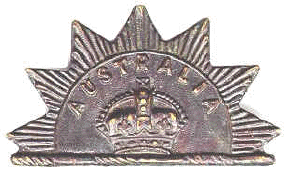 |
Milkman's hill on a hot summer's morning in April,
1898. There is a military camp in process of habilitation; staff
officers are cantering up and down the lines with orders, and Adjutants
are worrying over marching-in states. Out of chaos order is gradually
being established. |
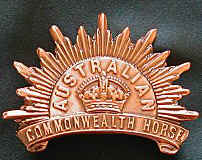 |
 |
For several hours there has been a constant inflow of
civilian horsemen mounted on country-bred animal of rough but
serviceable appearance. They ride like experienced bushmen, and one can
see at a glance that they are not mere sightseers. By noon there are
something like four hundred of them on the ground, and Quartermasters
are beginning to issue uniforms.
They are the First Australian Horse -
the new Cavalry Volunteers raised by Colonel Mackay - a Regiment of real
Bushmen, which in twenty-four hours from now will be seen marching past
the saluting base in myrtle-green uniform, with all the steadiness and
assurance of trained soldiers. |
This was the regimental debut. In June of the
previous year permission was given to raise a regiment of bush
volunteers, and in August it was gazetted. The movement was taken up
with boundless enthusiasm all over the colony; even Queenslanders
applied to be enrolled in the new organization. Only the Government gave
a tardy approval to the scheme, and this largely because there was money
to be found. Finally, however, sanction was given to raise four hundred
men on the basis of a capitation allowance of 5 pound per man, with
permission to the Officer Commanding, Colonel Mackay, to spend three or
four years' in advance.
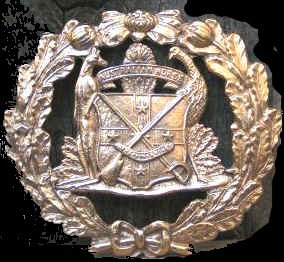 |

|
| Sabretache
badge of 1st Australian Horse |
Collar dog of the 1st Australian Horse |
As soon as the men enlisted they were measured for
their uniforms and an order was sent to London for four hundred separate
outfits, at a total cost of 7,000 pounds. Capt. Ferguson, of the 2nd Life
Guards, then acting as private secretary to the Governor, accepted the
posting of Second in Command with the rank of Major, and Sergt.
Thompson, of the New South Wales Lancers, was made Adjutant with a
Lieutenant's Commission.
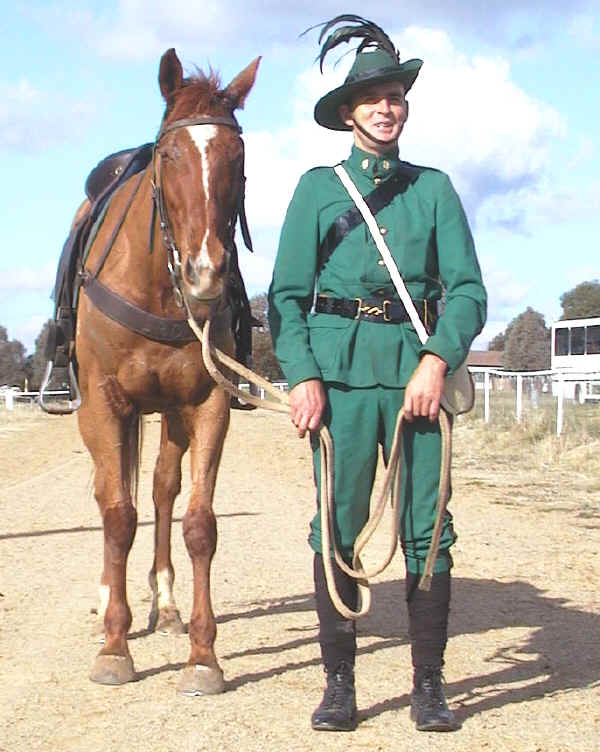 |
|
A re-created
Trooper's Uniform of the First Australian Horse |
Instructors of more or less fitness for the
position were appointed and drill inaugurated in the country districts.
Neither officers nor men knew the first thing about soldiering, but they
had an unbounded enthusiasm for their work and a good seat in the
saddle. With these advantages they made rapid strides towards
proficiency. Some of them rode forty miles to parade and another forty
back again, after three or four hours' drill. But the Easter encampment
was coming on, and the Officer Commanding had promised that they should
be there. Ship after ship arrived without the necessary uniform, with
swords or carbines, and still worse, without the Instructors who had
been cabled for.
Things looked far from encouraging as the time drew
near. The wonder is that the men did not lose heart entirely. They had
nothing to go to camp in except their civilian clothes, and they were to
be brigaded with the older regiments of Lancers and Mounted Rifles.
At last, on the Monday before Easter, a ship carrying
three tons of uniform and accoutrements put into port, and the Staff
were enabled to telegraph to their scattered units that their clothing
had arrived. There was no possible chance of issuing it locally, so
Colonel Mackay, relying on the loyalty of his men, asked them to come
into camp as they were and as lightly equipped as possible. At 4 a.m. on
Good Friday the first lot arrived - a motley crew, in every variety of
costume know to an Australian midsummer. By midday four hundred and two
out of a total strength of four hundred and ten had reported themselves
for duty. And then the fun began - at least for the Quartermaster. How
he got through his work even he is at a loss to comprehend, but the fact
remains that by daylight next morning the Regiment turned out for review
purposes.
Here was a body of men who knew nothing of military
camp routine; many had never handled a sword, and none knew how to use
one. In no case had more than forty been drilled together. The staff of
instructors was a borrowed one, consisting of artillery men and mounted
rifles. The whole of the uniforms, equipment, sword-frog, carbine
buckets, and one hundred and fifty swords had just been issued, and
still the regiment had to be put together, squadron and troop leaders
appointed, and the men were asked to walk, trot and canter past the
saluting base alongside their trained comrades within twenty-four hours!
This was an ordeal which very few regiments could
have survived. The Australian Horse not only accomplished it, but
remained in camp the whole nine days with their partially paid comrades,
without a penny of remuneration and without so much as a grumble. They
at once jumped into public favour, and kept there. It was a sporting
thing to do, and everyone admired the pluck and sprit which prompted it.
Colonel Mackay had promised two squadrons for the
camp: he marched past with four squadrons and a band! They were not,
perhaps as steady as a brick wall, but hey earned warm praise from
General Officer Commanding, and they deserved it.
In subsequent manoeuvres they showed a
quick-wittedness and grasp of details, so long as they were conveyed in
everyday language, which was quite surprising. How can one praise
sufficiently, the sprit which brought this regiment into existence under
such unfavourable conditions? It is still one of the most popular Corps
in the Service and one of the most useful.
In 1900 it was placed on the partially paid
establishment, and is now 638 strong. The original four squadrons have
been increased to five, and qualified instructors have been imported to
deal with the raw material. It should be remembered, however, that the
Regiment worked on the purely volunteer basis from its inception up to
this point, and sent a contingent of purely volunteer Cavalry to South
Africa.
The Southern or "A" Squadron is recruited
from Murrumburrah, Cootamundra and Gundagai; its strength is 120. The
South-Eastern or "B" Squadron includes men from Goulburn
(which also provides the band), Braidwood-Arulen, Michelago_Breadbow,
and Bungendore, and numbers 145 of all ranks. The Western or
"C" Squadron comes from Mudgee, Rylstone, and Lue, numbering
90: and the Scone or "D" Squadron from the township of the
same name, also Belltrees and Muswellbrook, to the number of 100. The
Northern or "E" Squadron is drawn from Gunnedah, Boggabri,
Tamworth, and Armidale; this numbers 145, or a total of 600 officers and
men, exclusive of Staff and band.
|

|
George Allman Griffen
was born at Braidwood NSW, in 1866. He was an accountant and
worked in Gundagai NSW, where he and his brother were active in
raising the local troop of the 1st Australian Horse in 1897. He
accompanied the unit's first contingent to South Africa in 1899
and held the rank of Squadron Sergeant Major. He
was killed in action on 16 January 1900 during a Boer
ambush at Slingersfontein and is buried in the military cemetery
at Colesburg. (His QSA is shown left)
Squadron Sergeant Major Griffen was the first
person from New South Wales to be killed in action in the Boer
War. His death had such an impact in Australia that a large
memorial tablet to his memory was unveiled in the Sydney Town Hall
on 22 April 1900. His death is also prominently recorded on the
face of the Boer War Memorial at Gundagai in NSW. |
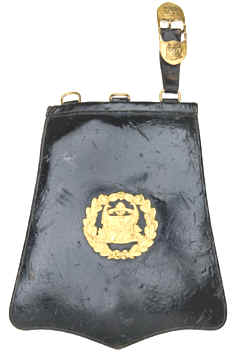 |
This sabretache was worn with full dress by Lieutenant
James Bunbury Nott Osborne as a member of the 1st Australian Horse. Raised
in New South Wales in 1897 as a partially-paid volunteer unit, the 1st
Australian Horse consisted of four squadrons, each of them about one
hundred men.
During the Boer War it provided two contingents, in 1899 and
1900. Osborne served with the first contingent, arriving in Cape Town on
13 December 1899. He was present at the battles of Slingersfontein and
Paardeberg and at the relief of Kimberley.
On 6 March 1900 Osborne
accepted a commission with the British 16th Lancers, a unit in which his
brother had served and died before the Boer War. He was closely involved
in the surrender of Bloemfontein and was later attached to General
French's headquarters, before being evacuated to England due to illness. |
|
Patent leather; Gilded brass; Brass; Black patent leather sabretache,
to be worn with full dress, with a large gilded brass badge of the 1st
Australian Horse attached to the centre front. Two of the three buckles
are missing. The third buckle is of gilded brass and shows the badge of
the unit at each end. There are attached 'D' rings to take the other two
buckles. The back of the sabretache has an expandable black leather pouch
which fastens with a flap and brass stud. The inside of the flap is lined
with green leather. There is an additional brass stud to secure the lower
strap that holds the pouch in place. |
BOER WAR
Of course, when it came to a question of sending
troops from New South Wales to South Africa, it was inevitable that some
of the Australian Horse should be included. No contingent would have
been representative with out men from this Corps, and the sequel showed
that the Regiment, although the most recently formed of any in the
State, justified its inclusion in the selection made for active service.
At first only thirty-four officers and men were sent
out, and these went with Mounted Rifles on the transport Langton Grange,
which carried a big cargo of horses.
Lieutenant W.V. Dowling was in charge when the vessel
sailed on November 13th. His little detachment was sent up via
Naauwpoort to Arundel, and operated under General French's command
during the whole of the running fights in the vicinity of Colesburg.
They were attached to the New South Wales Lancers when the second
detachment under Captain Thompson arrived by the Surrey. This lot
included 104 Officers and men. They landed on February 25th, 1900, at
Capetown, and on the 27th they were marching through the streets to the
accompaniment of the ringing cheers from the public, on their way to the
railway station at the front.
|
At Modder River they were placed in charge
of a convoy for Lord Robert's column, and marched across country to Klip
Drift, where they had their first brush with the enemy.
On March 7th the
detachment arrived at Paardeberg, and the following day pushed forward
to Poplar Grove to take part with the main army in the pitched battle now
memorable under this title.
From here on to Bloemfontein they were
actively engaged with the Cavalry Brigade under General French, (See
photo >>) and
fairly won their spurs.
|

|
At Bloemfontein they found Lieutenant Dowling, who
had been wounded and taken prisoner at Slingersfontein some weeks
earlier, when the Lancer patrol was ambushed and forced to surrender. In
this connection, it is interesting to note that Sergeant-Major Griffin
of the Australian Horse, was the first of the Australians to fall in the
service of the Empire. He was killed when Lieutenant Dowling was taken
prisoner.
The official report, written by Major Lee, Officer
Commanding New South Wales Lancers, on this mishap, runs as follows.
" Slingersfontein, 17-1-1900.- In reference to
the patrol of New South Wales and First Australian Horse that left camp
at 3 a.m. yesterday under Lieutenant W.V. Dowling, of the First
Australian Horse, the following is notified for record: The patrol after
leaving camp was attended by Major Lee as far as Pleese's farm. After
short halt Lieutenant Dowling moved on with patrol. At 3.30 p.m. Warrant
Officer Duncan reported his return to camp, also that he had been with
Lieutenant Dowling's patrol up till 1 p.m. The patrol had reconnoitred
according to instructions, and was about returning to camp when Warrant
Officer Duncan with two men, was detached to examine Mr. Foster's farm.
After doing so, he went in search of Lieutenants Dowling's part, and
failing to find them concluded they had returned to camp. At 4.30 p.m.
Major Lee received a message from Colonel Porter to see him at once in
reference to the patrol, and rode around immediately with Warrant
Officer Duncan and Private Buchholtz, and was informed that a New South
Wales Lancer patrol had been cut up. Colonel Porter proceeded to the top
of the adjacent hill, where Warrant Office Duncan and Private Buchholtz
explained all particulars. The Colonel considered the unfortunate
occurrence could not be classed otherwise than as an accident, and that
no one was to blame. It was decided after hearing the verbal evidence of
the Rimington Scouts (Bennet and two others) that we would wait
developments and see if any came in after dark. At 11.30 pm, Private
Artlett, Parramatta Half-squadron, returned to camp in an exhausted
condition.
" The position of the occurrence was located by
the Lancer scouts, some distance away on our left front. Upon
examination it was found the T.S.M. Griffin, No. 367, First Australian
Horse, had been killed from bullet wounds, one being through the head.
Corporal F. Kilpatrick, No. 755, New South Wales Lancers, was found
severely wounded - one bullet wound through the lungs, and the lower jaw
smashed as if by an explosive bullet. Owing to the Boers appearing on
our left flank in strength I withdrew all combatants from the front, and
sent on the ambulance. On return the medical officer reported that he
had buried T.S.M. Griffin on the spot where he had fallen, and that
Corporal Kilpatrick was in the ambulance expiring. Corporal Kilpatrick
died, at 5.10 p.m. was buried next to the two New Zealanders on the
slope above Slingersfontein Farm. The New South Wales and New Zealand
troop attended the burial. The following are still missing;-
|
New South Wales Lancers. |
|
|
Warrant Officer Fisher, C.E. |
Private Ford, M |
|
304 Sergeant McDonald, P. |
574 Private Roberts, J.A |
|
742 Corporal Hopf, C. |
866 Private Taylor, A.V. |
|
763 Private Daley, A. |
881 Private Whittington, G.B. |
|
880 Private Johnson, R.M. |
|
|
First Australian Horse |
|
|
Lieutenant W.V. Dowling, |
812 Private Eames, W. |
|
323 Corporal Wilson, R. |
680 Private
Lynee, R. |
" Warrant Officer Duncan will take on all duties
of Regimental Sergeant Major from this date." [Subsequent advices
show that the six members of the Lancer patrol who returned to camp are
Warrant Officer G.L. Duncan, Troopers Buchholtz, E, Thomas, H. Artlett,
H. Thomas, and W. Brady.]
For the remainder of the campaign, the Australian
Horse were attached to the Scots Greys, and in the appendix will be
found a list of the engagements in which they took part, together with
the casualty and honour roll for these services.
The success of the Regiment all through is largely
due to the untiring energy and enthusiasm of Colonel Mackay, in whose
brain the idea of bush volunteers originated. In the early days of the
New South Wales Lancers he had been an exceptionally zealous officer,
but he left that Corps when he entered Parliament. Subsequently, when
the idea of Imperial Bushmen for South Africa took hold of New South
Wales, he resigned his portfolio as Vice-President to the Executive
Council under the Lyne administration, and assumed command. For services
this connection he has been made Commander of the Order of the Bath.
In dealing with the services of both Lancers and
Australian Horse, it may fairly be stated, without prejudice to the
excellent work done by their comrades of the Mounted Rifles, that all
through the Campaign the identity of the New South Wales Cavalry
Contingents was overshadowed by the personality of the larger units to
which they were attached - the Inniskillings and the Scots Greys. For
this reason their work was not so prominently brought into the lime
light as that of the Mounted Rifles, who, from the time of their
disembarkation at Capetown, operated independently as a New South Wales
unit.
|

